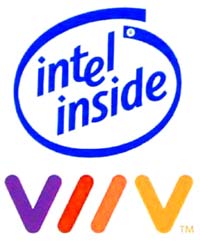
Via Furdlog: Intel’s new Viiv technology, the basis of a new range of dual-core processor ‘home media centres,’ will, apparently mean that:
“PCs would work with televisions and digital recorders and portable devices so people could move their entertainment wherever they wanted.” (LA Times story)
Sounds good (well, OK, it doesn’t exactly sound revolutionary), but to achieve this,
“that sort of integration requires coordination before devices roll off production lines or websites go online. A downloadable movie, for example, would have to be encoded with the proper software to take advantage of Viiv’s technology.”
I’m not sure quite what the ‘proper software’ means, but somehow I doubt it will be designed to allow people to “move their entertainment wherever they want”. Intel has signed deals with BSkyB, Canal+ and TiVo, so I’d guess that the content providers’ decisions on what can be done with their content will be fairly important. And websites having to be coordinated with Intel’s requirements “before… go[ing] online”? The LA Times article notes that:
Intel hopes to control a digital environment in which video and audio can move seamlessly around the world and around the house.
Maybe this should be taken to mean purely “control of the market” but does it imply more than that? Does it mean Intel (and its content partners) can stop any new entrants producing devices to interface with Viiv-based products?
Is control through integration a distinct classification in architectures of control? In a sense, all DRM/lockware is control through integration, but where devices are specifically designed to integrate to allow the promulgator to control the environment for innovation in technology, then this is close to what Ernest Miller and Andreas Bovens have noted (see discussion)–innovation lock-out through system architecture.